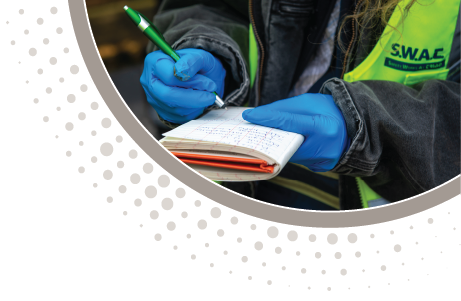Survey: Past, Present and Future
By: Ron Bidle
As Triad Engineering celebrates its 50th anniversary and I look back on my 38 years of experience, I am proud to be part of this profession and to be a small part of what surveying is today. Today, I serve as the Hagerstown Office Survey Practice Leader, and the changes I have seen in the field over the years have been significant. While technology has advanced, the core responsibilities of surveying have remained consistent. One key lesson I have learned is the importance of the responsibility that comes with being a surveyor. Early in my career, I did not really understand the legal and professional obligations tied to being a surveyor. Over time, I came to see that the role carries high expectations, not just in terms of accuracy but also in the trust our clients place in us. Since surveying is not widely understood by the public, I have made it a point to communicate clearly and act professionally on every project.
When I began in the late 1980s, we used theodolites and steel tapes for measurement and layout. Technology was limited, and most calculations were done manually. My math skills are unmatched. My training came through a mix of community college coursework and on-the-job experience. In fact, my first employer taught the courses I took, giving me both field and classroom experience and a job right out of school.
One of the biggest changes I have seen over the years is the evolution and introduction of GPS technology to the everyday workflow. In the early days of my career, very few firms had GPS equipment. If a project required datum control, we had to bring in a subcontractor. Now, GPS is a standard tool that has greatly improved efficiency and data accuracy. Check out last month’s blog for even more GIS information.
Despite these advances, many aspects of surveying remain the same. AutoCAD, which was introduced early in my career, is still widely used for data processing and drafting. Researching tax records, deeds, and plats before fieldwork continues to be a critical part of the process. These core tasks help to remind us that a strong foundation in the fundamentals is still essential, necessary, and as relevant as it was 38 years ago when I was first learning.
Today’s tools, like GIS data, robotic total stations, and advanced GPS systems, have significantly improved our overall workflow. In the past, we worked with limited data and slower processes. Now, we have access to real time information, faster turnaround, and more precise mapping capabilities.
Looking ahead to the next generation of surveyors, technology will continue to advance, but fieldwork will remain an essential part of the profession. This means the technician in the field is our greatest asset. There is still no substitute for being on site and collecting firsthand data. Training the next generation of surveyors looks a bit different than it did when I started, but still oddly the same. Safety is now a central part of the onboarding process, and new team members are learning to work with advanced technology from day one. Still, the fundamentals remain the same: research property records, gather accurate field data, and process it with care. While the tools keep evolving, these core skills are critical to every successful surveyor.
As Triad marks this milestone, I look back on how far both the surveying field and my own journey have come. I am proud of being part of this career. From steel tapes to GPS, the evolution of how we perform our trade may have changed, but the commitment to accuracy, integrity, and responsibility remains at the core of what we do. I look forward to seeing how surveying continues to evolve and how Triad will help shape its future.


